Part 6: The strange story of the station signage, Totems and platform lighting

The Cambridge totems, as depicted above and below, have been the subject of intrigue and rumour for decades, not least because none are known to have survived. The totem illustrated here is a replica made by Trackside of Derby and is as close as you could ever get to a genuine one.
 Mentioned elsewhere is the LNER's replacement of the station's casement gas lamps by the Suggs incandescent mantle type mounted on the original standards. Both types of lamp can be seen in various photographs in this feature. During LNER days what are usually referred to as 'lamp tablets' were installed. These were horseshoe-shaped enamel nameplates suspended from gas lights. Cambridge is known to have had them but photographs are difficult to find; one exists showing some in situ in 1946 but at the time of writing that is the only evidence we have.
Mentioned elsewhere is the LNER's replacement of the station's casement gas lamps by the Suggs incandescent mantle type mounted on the original standards. Both types of lamp can be seen in various photographs in this feature. During LNER days what are usually referred to as 'lamp tablets' were installed. These were horseshoe-shaped enamel nameplates suspended from gas lights. Cambridge is known to have had them but photographs are difficult to find; one exists showing some in situ in 1946 but at the time of writing that is the only evidence we have.
 Railway company records can be vague when it comes to relatively minor matters, often categorising them simply as 'alterations', and BR was no exception on the matter of Cambridge totems. However, we can establish, with the help of photographic evidence, that Cambridge station received its totems in the late 1952 to early 1953 period.
Railway company records can be vague when it comes to relatively minor matters, often categorising them simply as 'alterations', and BR was no exception on the matter of Cambridge totems. However, we can establish, with the help of photographic evidence, that Cambridge station received its totems in the late 1952 to early 1953 period.
The Suggs gas lamps were suspended in the familiar manner beneath the canopies but on the open sections of platform there was no uniformity whatsoever. For platform 1/2 the lamps were mounted in harp-shaped frames with rimmed hoods and vertical ventilation louvres but at the other end of the station on platform 4/5 they had the same frame but with more ornate 'Chinese Hat' hoods. platform 3 had swan-neck lamps while platform 6 had an entirely different arrangement; lamps cantilevered out from the engine shed wall and, beyond the shed wall, the same type of lamp as on platform 4/5.
The method of mounting the totems also lacked uniformity and a rather odd arrangement was used for platforms 1/2. The totems were mounted on the harp frame but outstretched on two struts.
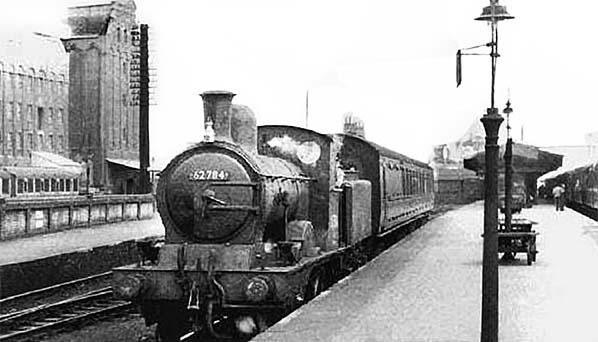
 Above; the little drawing on the left is crude but shows how the platform 1/2 totems were mounted. The image on the right shows how the totems were alternated - that in the foreground facing platform 1 and that further along the platform facing platform 2. The origin of the image of 62784 is unknown. If anybody can help in this respect then please get in touch. The E4 is departing with a short two-carriage train and will branch off at Shelford Junction onto the Stour Valley line. The locomotive has a 'water-cart' tender and several photographs exist of 62784 so-partnered. Behind the photographer, one of original casement lamps continued to stand adjacent to the water crane until electric lighting was installed.
Above; the little drawing on the left is crude but shows how the platform 1/2 totems were mounted. The image on the right shows how the totems were alternated - that in the foreground facing platform 1 and that further along the platform facing platform 2. The origin of the image of 62784 is unknown. If anybody can help in this respect then please get in touch. The E4 is departing with a short two-carriage train and will branch off at Shelford Junction onto the Stour Valley line. The locomotive has a 'water-cart' tender and several photographs exist of 62784 so-partnered. Behind the photographer, one of original casement lamps continued to stand adjacent to the water crane until electric lighting was installed.
The image of G5 No.67322 in Part 5 shows a pair of totems mounted back to back on a lamp standard on platform 4/5. Above is a detail from a larger version of that image. It will be noticed that the lamp standards themselves were of different styles at each end of the main platform and this probably came about through being installed at different times when platforms were widened and/or extended. The peculiar way of mounting the totems at the south end was not, incidentally, unique to Cambridge.
Below another outreached totem can be seen although the actual arrangement is slightly different to that at Cambridge. The lamp itself is also missing, perhaps it is being repaired. The occasion is an RCTS special at Haverhill North on 10 August 1958, 8½ years before the Stour Valley Line closed. The train had just come off the Colne Valley Line. Further details and images of this tour can be seen here.
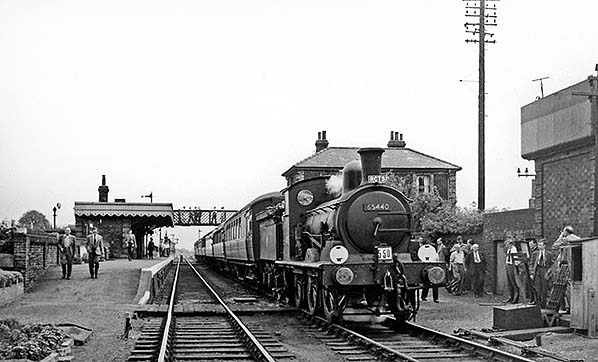
Photo by Ben Brooksbank
Of the Cambridge platforms not yet mentioned, on platform 6 the totems were suspended from and behind the cantilevered lamps while beneath the canopies of platform 3 and the main station building they were suspended from the canopies and behind, but lower than, the lamps. As far as can be determined, the open air section of platform 3 had no totems. Until recent times this was a relatively short platform but it had a running-in board at its south end which no doubt sufficed.
Photographic evidence tells us the totems had been removed by October 1955 so they had a life of no more than three years. The Eastern Region blue running-in boards, however, outlived them by many years. Local memories maintain that one totem survived a little longer under the canopy of platform 3 but at the time of writing no conclusive evidence of this has been found.
What happened to the totems, which would have still been as good as new, after they were removed has been a subject of rumour ever since. The most common rumour says they were simply dumped in an ash pit but the problem is which ash pit. The only such pits remaining at the time were still in regular use and would have been emptied periodically so this makes the ash pit rumour rather dubious. Station totems are today very valuable collectors items but we should remember that back in the 1950s they were not and when discarded they were merely worthless junk. For that reason, when many closed stations were being stripped of their fittings it was not uncommon, especially in rural locations, for totems and other items to be buried in a specially dug pit and simply forgotten. Many which have survived did so through being 'acquired by stealth' or by slipping the men dismantling a station a pound or two. BR themselves were always willing to sell them; all you had to do was write to them and on payment of a small fee, usually around £2, you would receive written permission to go and remove a totem yourself. There was no fuss, no health and safety rigmarole and hi-viz had not yet been invented - it really was that simple. Much later, of course, totems began to increase in value and the days of "you can have it for a couple of pounds" soon became history.
Insofar as Cambridge is concerned, as far as is known not a single totem was saved but they must be out there somewhere; buried, hidden, maybe laying forgotten in some dusty upstairs room of the station building. Perhaps they are buried in the old subway which once linked to the original island platform although nothing was seen when this was uncovered in 1981. If the ash (or inspection) pit rumour is to be taken as fact, a possible location is the former LNWR engine shed as this was finally demolished around the same time as the Cambridge totems were removed. The only thing we can be sure of is that we will probably never know the truth and the rumours will continue to prevail.
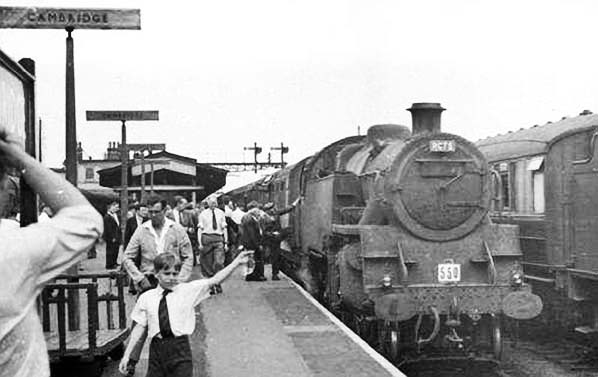 Photo from John Debens collection
Photo from John Debens collection
Cambridge was one of several stations in the region and beyond which, from 1955 onwards, were fitted with fluorescent lamps mounted on precast concrete posts as seen above during a visit by the R.C.T.S. (London Branch) The Northern & Eastern Rail Tour on 10 August 1958. The fluorescent tubes were inside plastic casements (we will refer to these as shades hereinafter, to avoid confusion with the earlier gas lamp casements) which had the station name on them, both sides, in black block capital letters. Those at Cambridge were almost as muddled as the totems; originally on platforms 1/2 all were mounted with the shades parallel to the platform edges but alterations soon came which saw these turned through 90° so the names faced incoming trains, apart from those at the extreme south end, where the platform narrowed, which remained parallel to the platform edge. On platforms 4/5 and as far as can be ascertained, the lamps were mounted with their shades at 90° to the platform edges from the outset.
Beneath the canopy on the main station building, the fluorescent lamps were suspended from the canopy in the same way as the gas lamps had been. On platform 6 they were fixed to the shed wall but not cantilevered out like the gas lamps had been. The shades of these lamps differed to those elsewhere on the station; the bottom edge was chamfered at something like 45° and each alternate shade had the station name on it in the same black capital letters. When the shed was demolished, these lamps were replaced by the same post-mounted type as found on the rest of the station.
At an unknown date, probably c1970, the concrete lamp posts were replaced by galvanised metal posts and for some reason which remains a mystery the station name was removed from each and every shade. As far as can be ascertained, this occurred when BR introduced their corporate identity black and white signage to Cambridge station.
That was not the end of the story, though. Not all the fluorescent lamp shades were original to Cambridge; when a station name had been removed and the shade left blank or replaced with another name, the outline of the original name remained clearly visible at close quarters. At least two of the lamp shades at Cambridge had originated at Newmarket while another very clearly showed the outline of Saffron Walden. What is so unusual about that, readers may be asking. Actually nothing insofar as Newmarket is concerned but Saffron Walden is a different matter entirely. Saffron Walden station closed in 1964 and was gas lit to the end. The existence of at least one fluorescent, named lamp for Saffron Walden can almost certainly be put down to an error in some BR office or other. Such errors were not uncommon and in the case of Saffron Walden may have come about through a plan to install electric lighting without realising the station had no electricity supply - if that was indeed the case. Even in the 1960s smaller stations with no mains electricity were still quite common.
On a somewhat brighter note, the one-time wooden platform seats on Cambridge station had cast iron nameplates fixed to them. These had been provided by the LNER and one or two, at least, of these plates are known to have survived.
In 1982 Cambridge fell within the London & South Eastern sector of British Rail and from 1986 this sector was renamed to the more familiar Network SouthEast under the directorship of Chris Green - one of the more respected railway figures of modern times. Under NSE, Cambridge station received a makeover reflecting its new status and much of the BR lighting, seating and signage was swept away. The new NSE image was a trifle clinical but at the same time refreshing and somehow appropriate.
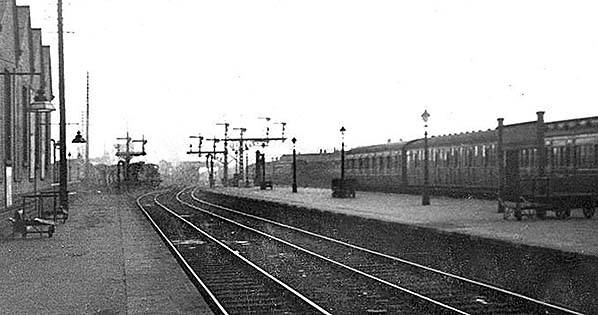
Photo by John Ford from David Ford's Flickr photostream
The above image is a little out of sequence, date wise, but is included as it is a view of the north bay from a rarely seen angle. On the left two of the gas lamps cantilevered from the engine shed wall can be seen and complete with their ornate shades. Lamps so-shaded could also be seen inside the station building, the most well known examples being in the refreshment room and booking hall. These were of the same general style but much more ornate and in pendant form. On the right the platform 4/5 running-in board is seen. This was later replaced by a BR blue example. There is no obvious sign of the lamp tablets on platform 4/5, if indeed it had any; the only photographic evidence which has turned up shows them on platform 1/2 but no such evidence of them on other platforms has so far come to light.
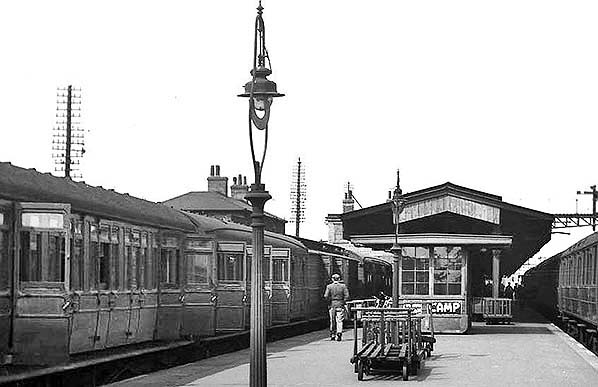
Photo from Duncan Chandler's GER Album
Above is one of the few known photographs showing lamp tablets on Cambridge station. It is another of the images thought to have been taken by F.V.Russell but, as with the previous such image, was taken too late. The coaching stock is still in LNER livery and the platform edging suggests wartime or later. Note the articulated suburban stock on the left; doors left open at the terminus - a typical commuter train scenario.
The tablets are also just visible in the image of Bulleid 34057 in Part 5, so we know they survived into the BR period and in all likelihood were directly replaced by BR totems.
Enamel advertisements, once a common sight everywhere and not just on the railways, help to brighten the otherwise drab station. In GER days even the columns supporting the canopy were adorned with advertisements. The gas lamps were quite wonderful and, like steam locomotives, oozed a sense of being alive. The lamps, atop their ornate standards, gave a gentle hiss and an adequate but not brilliant light which was somehow reassuring. The Suggs lamps on Cambridge station appear to have been of the type using a permanently-burning pilot light, similar in principle to that of a domestic gas boiler. They also appear to have been of the triple mantle type.
Click here for Part 7: British Railways - The diesel era
or return to Cambridge home page


 Mentioned elsewhere is the LNER's replacement of the station's casement gas lamps by the Suggs incandescent mantle type mounted on the original standards. Both types of lamp can be seen in various photographs in this feature. During LNER days what are usually referred to as 'lamp tablets' were installed. These were horseshoe-shaped enamel nameplates suspended from gas lights. Cambridge is known to have had them but photographs are difficult to find; one exists showing some in situ in 1946 but at the time of writing that is the only evidence we have.
Mentioned elsewhere is the LNER's replacement of the station's casement gas lamps by the Suggs incandescent mantle type mounted on the original standards. Both types of lamp can be seen in various photographs in this feature. During LNER days what are usually referred to as 'lamp tablets' were installed. These were horseshoe-shaped enamel nameplates suspended from gas lights. Cambridge is known to have had them but photographs are difficult to find; one exists showing some in situ in 1946 but at the time of writing that is the only evidence we have. Railway company records can be vague when it comes to relatively minor matters, often categorising them simply as 'alterations', and BR was no exception on the matter of Cambridge totems. However, we can establish, with the help of photographic evidence, that Cambridge station received its totems in the late 1952 to early 1953 period.
Railway company records can be vague when it comes to relatively minor matters, often categorising them simply as 'alterations', and BR was no exception on the matter of Cambridge totems. However, we can establish, with the help of photographic evidence, that Cambridge station received its totems in the late 1952 to early 1953 period.
 Above; the little drawing on the left is crude but shows how the platform 1/2 totems were mounted. The image on the right shows how the totems were alternated - that in the foreground facing platform 1 and that further along the platform facing platform 2. The origin of the image of 62784 is unknown. If anybody can help in this respect then please get in touch. The E4 is departing with a short two-carriage train and will branch off at Shelford Junction onto the Stour Valley line. The locomotive has a 'water-cart' tender and several photographs exist of 62784 so-partnered. Behind the photographer, one of original casement lamps continued to stand adjacent to the water crane until electric lighting was installed.
Above; the little drawing on the left is crude but shows how the platform 1/2 totems were mounted. The image on the right shows how the totems were alternated - that in the foreground facing platform 1 and that further along the platform facing platform 2. The origin of the image of 62784 is unknown. If anybody can help in this respect then please get in touch. The E4 is departing with a short two-carriage train and will branch off at Shelford Junction onto the Stour Valley line. The locomotive has a 'water-cart' tender and several photographs exist of 62784 so-partnered. Behind the photographer, one of original casement lamps continued to stand adjacent to the water crane until electric lighting was installed.

 Photo from John Debens collection
Photo from John Debens collection


 Home Page
Home Page